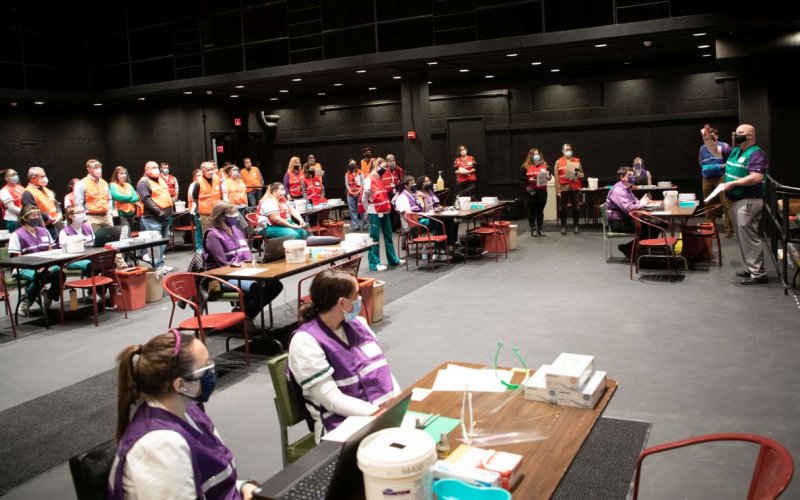So Many Reasons to Volunteer at UAlbany’s Vaccination PODs

ALBANY, N.Y. (April 6, 2021) — For Christine Priest, volunteering at UAlbany’s vaccine clinic last month was driven by her desire to play a role in ending the forced isolation that the COVID-19 pandemic has brought to all our lives. “Volunteering allowed me to be part of the efforts to get everyone back to our lives and regular routines again,” she said.
Charles Rogers has seen too many close relatives of his closest friends die from COVID-19. “Most of the people we know who have passed have been people of color and that is one of the main reasons I volunteer.”
Zakhar Berkovich’s decision was influenced by the Jewish tradition of Tikkun Olam, which literally translates to “repair the world” but encompasses the idea of working constructively and beneficially for others. “This is what my parents taught me growing up,” he said.
The three volunteers were among the more than 120 helping out at UAlbany’s first Closed Point of Delivery (CPOD) vaccination clinic on March 18. A second CPOD will be held at SEFCU Arena today, the same day eligibility for the vaccine opens to all New Yorkers 16 and older. Those vaccinated at the first two COPDs require second doses, which are scheduled for April 15 and 27.
UAlbany does not have direct access to the vaccine, but received a limited number of doses from Albany County’s Department of Health. The University expects to receive more doses from the county for future vaccination clinics, and the need for volunteers is great.
“We are hoping to eventually be able to do full-scale POD operations, with the county providing over a thousand doses for each,” said Peter Evans, who is coordinating the CPODs as a member of the University’s Incident Management Team. Evans, the associate director of the Office of University Events, added that UAlbany expects future CPODs will administer the Johnson & Johnson vaccine, which only requires one dose. That would make it easier for students to get vaccinated before they leave campus at the end of the semester.
At least 125 volunteers are needed for each vaccine event. Anyone 18 and over can volunteer, and jobs include checking patients in and out, helping them with registration on the state vaccination database, and monitoring people for adverse reactions to the vaccine. For information on how to sign up, email [email protected].
So why volunteer? Here’s why some members of the University community decided to step up.
Charles Rogers, the associate dean of students, will be working at today’s CPOD. He said helping out is a way to support the essential workers on campus as well as communities of color, which have seen a higher incidence of COVID cases and deaths.
“As an African American male with high blood pressure myself, my wife has worries about my safety,” said Rogers, who works afternoons on campus and mornings at home. “But I’ve lost friends. And for all the front-line people who have to work on campus, including the resident assistants and resident directors who don’t have the option to stay home – that’s why I decided to volunteer.”
Zakhar Berkovich, the director of Undergraduate Student Services at Rockefeller College of Public Affairs & Policy, has his own family and cultural reasons for volunteering. He said he also was drawn to help by his interest in science.
“As a former EMT and a biology major, I am still fascinated by many medical advances,” he said. “The creation of a vaccine, within a year, that is 95 percent effective in developing a positive immune response to a virus is just incredible. I wanted to be part of this scientific progress, even in a small role.”
Berkovich added that his own positive experience at a vaccine clinic at the Albany Armory made him want to help create a similar experience and level of service at UAlbany, and to help convince others that getting vaccinated is safe and beneficial. “Being present and offering my skills and time may just do that,” he said.
Christine Priest, the training and development coordinator for the University’s Office of Human Resources, said the experience of volunteering itself was rewarding. “It was wonderful to be a part of the change in relation to COVID-19,” she said. “Seeing and interacting with so many colleagues who came to get their vaccinations really made me feel like we are heading in the right direction to combat this virus and return to life again soon. It was great to finally see colleagues again in person, as opposed to through a screen, which has been challenging throughout the last year.”
Priest, who also serves as the University’s interim Employee Assistance Program coordinator, said her family has been affected by COVID-19, both by the disease itself and the pain of isolation. “It was uplifting to think about how many are working against this virus, by getting the vaccination and supporting the vaccination efforts. I anticipate these efforts will help everyone as we move forward.”




